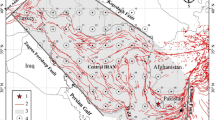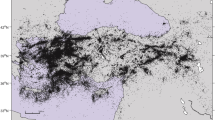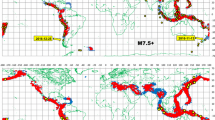Abstract
The M8 algorithm is one of the most reliable intermediate-term middle-range earthquake prediction algorithms. The present study evaluates the ability of the M8 algorithm and its modified versions for predicting major events (M7+) in Turkey. Thirty different algorithms were developed by changing the radius of circle of investigation (CI) and the lower magnitude cutoff of the M8 algorithm. These modified algorithms were executed all over the territory of Turkey, and the results were evaluated using the error diagram. Each modified algorithm was executed for consecutive half-year intervals over a specified period of time. Subsequently, the seismic catalog was updated, and failures-to-predict ratio and the fraction of alarm were considered. Results showed that the location of areas of alarm change gradually over consecutive intervals, and no sudden changes can be observed. In addition, the annual changes of areas of alarm are not random and follow a pattern. This study also showed that the modified algorithm having a three to six annual average of events and a 393-km CI radius is an efficient algorithm for predicting the future seismic events in Turkey. This algorithm predicted six out of six target events, retrospectively, with a confidence level of 96.4 %. According to the obtained results, it will be possible to rely on this modified algorithm to predict near future earthquakes of Turkey. Furthermore, this study proves that it is possible to alter the M8 algorithm for being used in regional studies.










Similar content being viewed by others
References
Allen CR, Edwards W, Hall WJ, Knopoff L, Raleigh CB, Savit CH, Toksoz MN, Turner RH (1976) Predicting earthquakes: a scientific and technical evaluation—with implications for society, Panel on Earthquake Prediction of the Committee on Seismology, Assembly of Mathematical and Physical Sciences. National Research Council, U.S. National Academy of Sciences, Washington
Allen MB, Jackson J, Walker R (2004) Late Cenozoic reorganization of the Arabia-Eurasia collision and the comparison of short-term and long-term deformation rates. Tectonics 23(2):TC2008
Ambraseys NN (1988) Engineering seismology. Earthq Eng Struct Dyn 17:1–105
Ambraseys N N (2009). Earthquakes in the eastern Mediterranean and the Middle East: a multidisciplinary study of 2000 years of seismicity, Cambridge University Press pp. 968. (ISBN 9780521872928)
Ambraseys NN, Adams R (1986) Seismicity of West Africa. Ann Geophys 4B:679–702
Ambraseys NN, Finkel C (1987) Seismicity of Turkey and neighbouring regions 1899-1915. Ann Geophys 5:701–726
Ambraseys N N, Finkel C (1995). The seismicity of Turkey, M.S. Eren (Beyoğlu, Istanbul) pp. 223 ISBN 9757622389 (also transl. into Turkish)
Ambraseys NN, Melville CP (1982) A history of Persian earthquakes. Cambridge University Press, Britain
Ambraseys NN, White D (1997) The seismicity of the eastern Mediterranean region 550 Ð 1 BC: a re-appraisal. J Earthq Eng 1:603–632
Ambraseys NN et al (1983) Notes on historical seismicity. Bull Seism Soc Am 73:1917–1920
Dewey JF, Pitman WC, Ryan WBF, Bonnin J (1973) Plate tectonics and the evolution of the Alpine system. Geol Soc Amer Bull 84:3137–3180
Dobrovolsky IR, Zubkov SI, Myachkin VI (1979) Estimation of the size of earthquake preparation zone. Pure Appl Geophys 117:1025–1044
EMME (2013). Digital faults map, earthquake model of the Middle East Region: hazard, risk assessment, economics & mitigation implementation plan
Erhan A, Iain SS, Aykut B, Luigi P (2003) Earthquake faulting at ancient Cnidus, SW Turkey. Turk J Earth Sci (Turkish J Earth Sci) 12:pp. 137–151
Healy J H, Kossobokov V G, Dewey J W (1992) A test to evaluate the earthquake prediction algorithm, M8, U.S. Geol. Surv. Open-File Report 92-401, 23 p
Keilis-Borok VI, Kossobokov V G (1984). A complex of long-term precursors for the strongest earthquakes of the world. Proc. 27th Geological Congress vol. 61. Nauka, Moscow, pp. 56–66
Keilis-Borok V I, Kossobokov V G (1987). Periods of high probability of occurrence of the world’s strongest earthquakes. Computational Seismology vol. 19. Allerton, pp. 45– 53
Keilis-Borok V I, Kossobokov V G (1988). Premonitory activation of seismic flow: Algorithm M8. Lecture Notes of the Workshop on Global Geophysical Informatics with Applications to Research in Earthquake Prediction and Reduction of Seismic Risk (15 Nov.–16 Dec., 1988), ICTP, Trieste, 17 p
Keilis-Borok VI, Knopoff L, Rotvain IM, Sidorenko TM (1980) Bursts seismicity as long-term precursors of strong earthquake. J Geophys Res 85:803–811
Kossobokov VG (1986) The test of algorithm M8. In: Sadovsky MA (ed) Algorithms of long-term earthquake prediction. CERESIS, Lima, pp 42–52
Kossobokov V G (1997). User manual for M8. In: Healy, J.H., Keilis-Borok, V.I., Lee, W.H.K. (Eds.), Algorithms for earthquake statistics and prediction, IASPEI Software Library vol. 6. Seismol. Soc. Am., El Cerrito, CA
Kossobokov VG (2006) Testing earthquake prediction methods: The West Pacific short-term forecast of earthquakes with magnitude MwHRV = 5.8. Tectonophysics 413:25–31
Kossobokov VG (2011) Are mega earthquakes predictable? Izv Atmos Ocean Physics 46(8):951–961
Kossobokov V G (2012). Earthquake prediction: 20 years of global experiment. Natural Hazard, vol. 52, no. 1
Kossobokov VG, Healy JH, Dewey JW (1997) Testing an earthquake prediction algorithm. Pure Appl Geophys 149:219–232
Kossobokov VG, Romashkova LL, Keilis-Borok VI, Healy JH (1999) Testing earthquake prediction algorithms: statistically significant advance prediction of the largest earthquakes in the Circum-Pacific, 1992–1997. Phys Earth Planet Inter 111:187–196
Kossobokov VG, Romashkova LL, Panza GF, Peresan A (2002) Stabilizing intermediate-term middle-range earthquake predictions. J Seismol Earthq Eng 8:11–19
Latoussakis J, Kossobokov VG (1990) Intermediate term earthquake prediction in the area of Greece: application of the algorithm M8. Pure Appl Geophys 134(2):261–282
McKenzie DP (1972) Active tectonics of the Mediterranean region. Geophys J R Astron Soc 30:109–185
Molchan GM (1997) Earthquake prediction as a decision-making problem. Pure Appl Geophys 149:233–247
Molchan GM (2003) Earthquake prediction strategies: a theoretical analysis. In: Keilis-Borok VI, Soloviev AA (eds) Nonlinear dynamics of the lithosphere and earthquake prediction. Springer, Heidelberg, pp 209–237
Molchan GM (2010) Space-time earthquake prediction: the error diagrams. Pure Appl Geophys 167:8–9. doi:10.1007/s00024-010-0087-z
Peresan A, Kossobokov VG, Romashkova L, Panza GF (2005) Intermediate-term middle-range earthquake predictions in Italy: a review. Earth Sci Rev 69:97–132
Şengör AMC, Yılmaz Y (1981) Tethyan evolution of Turkey: a plate tectonic approach. Tectonophysics 75:181–241
Şengör AMC, Ozeren S, Genc T, Zor E (2003) East Anatolian high plateau as a mantle-supported, north-south shortened domal structure. Geophys Res Lett 30(24):8045. doi:10.1029/2003GL017858
Silverman BW (1986) Density estimation for statistics and data analysis. Chapman and Hall, New York
Volkan K (2011) Geological, geomorphological and archaeoseismological observations along the Cibyra Fault and their implications for the regional tectonics of SW Turkey. Turk J Earth Sci (Turkish J Earth Sci) 20:429–447, 2011
Author information
Authors and Affiliations
Corresponding author
Appendix 1 (M8 algorithm)
Appendix 1 (M8 algorithm)
The M8 algorithm consists of the following steps:
-
1.
Determination of the target magnitude: The M8 algorithm is designed to predict the earthquakes greater than the magnitude of M 0. The magnitude range of target events is between M 0 and M 0 + Δm, where Δm is less than 1. In the case of having an adequately complete dataset, different overlapping ranges of M 0 with increments of 0.5 can be considered. However, sometimes, a natural cutoff magnitude is suggested by the actual distribution of earthquake size.
-
2.
Determination of the investigation area: The understudy region is fully covered by overlapping circles of investigation, CIs, of a fixed radius (R(M 0) = (exp(M 0 − 5.6) + 1) × 111/2). CI of M8 algorithm is proportional to the linear dimensions of the target earthquakes and are about three to four times smaller of their preparation zone, e.g., R = 100.43M (Dobrovolsky et al. 1979).
-
3.
Preparation of the catalog: Within each CI, the sequence of main shocks is considered. So, removing aftershocks and declustering of the events should be performed by means of a well-known algorithm, such as that of Keilis-Borok et al. (1980). Each main shock is characterized by the vector of [t i , m i , h i , b i (e)], where i (i = 1, 2, …) is the number of the main shock, t i is its origin time, m i is its magnitude, h i is its focal depth, and b i (e) is the number of aftershocks of magnitude M aft and above happening during the first e days. The sequence is normalized by the lower magnitude cutoff, M = M min (Ñ), where Ñ is a standard value of the average annual number of earthquakes in the sequence.
-
4.
Computation of the main M8 functions: For each CI, in a sliding time window of (t-s, t) and magnitude range of [m, M 0), several average values should be computed to quantify the features of seismic sequence. These values are as follows:
-
(i)
N (t): The number of earthquakes of magnitude m or greater in the time window of (t-s, t). This function represents the rate of seismic activity; N (t) = N (t| m, s).
-
(ii)
L (t): The deviation of seismic activity from a longer-term trend over the period of (t 0, t); L(t) = L (t | m, s, t 0) = N (t | m, s) − N (t-s | m, t-s-t 0) × s/(t-s-t 0).
-
(iii)
Z (t): The linear concentration of main shock sources which is equal to the ratio of the average source diameter to the average distance between sources. This function indicates the linear concentration of earthquake sources; Z (t) = Z (t | m, M 0 − g, s, α, β)
-
(iv)
B (t): The maximum number of aftershocks, b i (e), among events of magnitude range of [M 0 − p, M 0 − q] during time interval of (t-s, t). Each of the functions of N, L, and Z are calculated twice for different magnitude cutoffs (M = M min (Ñ), for Ñ = 10 and 20). Therefore, the seismic sequence is characterized by average values of seven functions, including N 1, N 2, L 1, L 2, Z 1, Z 2, and B.
-
(i)
-
5.
Determining TIPs “very large” values for each function are defined as the values higher than the Q percent of all of the encountered values. Whenever at least six out of seven abovementioned functions, including B, become very large, in a specified narrow time window of (t-u, t), a time of increased probability of earthquake of magnitude M 0+, TIP, starts. Also, this alarm or TIP should last for two successive time frames, t and t + 0.5. The following values of N (t), L (t), and Z (t) functions defined the original version of the M8 algorithm: D (M 0) = {exp (M 0 − 5.6) + 1} in degrees of meridian, which is equal to 384, 560, 854, and 1333 km for M 0 = 6.5, 7.0, 7.5, and 8, respectively; s = 6 years; s′ = 1 year; g = 0.5; p = 2; q = 0.2; u = 3 years; and Q = 75 % for B and 90 % for the other six functions. The value of 5.6 in the formula of D (M 0) is the normalizing value that makes D (M 0 = 8.0) = 12° in degrees of the Earth’s meridian, same as that of Keilis-Borok and Kossobokov (1987).
Rights and permissions
About this article
Cite this article
Mojarab, M., Memarian, H. & Zare, M. Performance evaluation of the M8 algorithm to predict M7+ earthquakes in Turkey. Arab J Geosci 8, 5921–5934 (2015). https://doi.org/10.1007/s12517-014-1624-3
Received:
Accepted:
Published:
Issue Date:
DOI: https://doi.org/10.1007/s12517-014-1624-3




